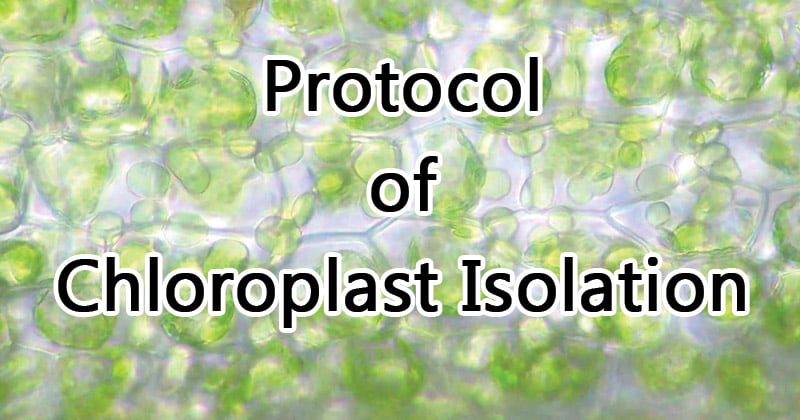- The chloroplast is an important organelle found in plant cells that conduct photosynthesis.
- It is enclosed by a pair of closely spaced membranes, the double-membrane envelope, consisting of the inner membrane bounding the matrix or stroma and the outer membrane in contact with the cytoplasm.
- Chloroplasts are the best starting material for studies of chloroplastic processes such as carbon assimilation, electron flow and phosphorylation, metabolic transport, or protein targeting.
- The chloroplast fraction can be further extracted to obtain membrane, stroma, or thylakoid proteins as well as chloroplastic DNA and RNA.

Interesting Science Videos
Principle
In chloroplast isolation method, first the cell wall is broken mechanically using a blender or homogenizer and then subjected to filtration to remove the unbroken leaf tissue and the cellular debris. The chloroplasts are collected by centrifugation using a percoll gradient which is a form of density gradient centrifugation on the modified silica sol “Percoll.”
Percoll gradient separator works on the principle of isopycnic separation. In this type of separation, a particle of a particular density will sink during centrifugation until a position is reached where the density of the surrounding solution is exactly the same as the density of the particle. Once this quasi-equilibrium is reached, the length of centrifugation does not have any influence on the migration of the particle and thus can be separated.
Materials Required
- Spinach leaves 30 grams
- Scissors
- Blenders and Homogenizers
- Muslin cloth.
- Centrifuge tubes
- Pipettes
- Cooling centrifuges.
- Spectrophotometer
- 1x Chloroplast isolation buffer without BSA: 0.33M sorbitol, 0.1M tris-Cl ph 7.8, 5mM MgCl2, 10mM NaCl, 2mM EDTA.
- 1x Chloroplast isolation buffer with BSA (0.1%w/v)
- 40% percoll : 4ml percoll and 6 ml 1x CIB buffer with BSA to make 10 ml of 40% percoll. (Use 10 ml of 40% percoll for 6ml of chloroplast suspension)
- 80% acetone.
Procedure
- Take freshly harvested leaf (spinach) 35 g (wet wt.)
- Remove the midrib veins of the leaves and dice into small segments (1 cm in width)
- Immediately homogenize by blending for 2 sec in 120 ml of buffer (pH 6.1) with BSA
- Briefly filter the resulting homogenate through multiple layers of muslin cloth.
- Divide the filtrate into centrifuge tubes and centrifuge at 2,500 x g for 70 sec at 4°C.
- Transfer the supernatant into chilled centrifuge tubes and centrifuge at 1000xg for 7 minutes. A green pellet will be obtained.
- Discard the supernatant and break the green pellet gently by finger tapping.
- Resuspend the pellet in 2ml of 1x CIB buffer with BSA and mix gently by pipetting up anddown. Pool the suspended pellet into one centrifuge tube.
- Carry out gradient centrifugation in Percoll.
Preparation of 40% percoll layer: Mix 4 ml percoll with 6 ml of 1x CIB buffer with BSA.
- Gently overlay 6ml of the chloroplast suspension over this 40% percoll layer.
Centrifuge at 1700 xg for 6 minutes. - Carefully remove the upper layer of the chloroplast suspension leaving only the pellet containing the intact chloroplast.
- Mix the pellet with 500 ul of 1x CIB buffer without BSA.
- Add the suspension in 80% acetone solution (10 ul in 992ul) mix and centrifuge at 3000xg for 2 minutes. Take supernatant into a cuvette and measure the absorbance at 650 nm using 100 ul of 80% acetone as blank to estimate chlorophyll concentration if required.
Expected Result
- The intact chloroplast sediments to the bottom of the tube after Percoll centrifugation as a green pellet.
- Broken chloroplast will form the upper layer.
References
- amrita.edu,(2011). Isolation of Chloroplast. Retrieved 31 October 2018, from vlab.amrita.edu/?sub=3&brch=187&sim=878&cnt=2
- https://www.sigmaaldrich.com/content/dam/sigmaaldrich/docs/Sigma/Bulletin/cpisobul.pdf
- https://www.researchgate.net/publication/271262113_Isolation_of_intact_and_pure_chloroplasts_from_leaves_of_Arabidopsis_thaliana_plants_acclimated_to_low_irradiance_for_studies_on_Rubisco_regulation
- Wang, S., Uddin, M. I., Tanaka, K., Yin, L., Shi, Z., Qi, Y., Mano, J., Matsui, K., Shimomura, N., Sakaki, T., Deng, X. and Zhang, S. (2014). Maintenance of chloroplast structure and function by overexpression of the rice MONOGALACTOSYLDIACYLGLYCEROL SYNTHASE gene leads to enhanced salt tolerance in tobacco. Plant Physiol 165(3): 1144-1155.
- Wang, S., Yin, L., Mano, J. and Tanaka, K. (2015). Isolation of Chloroplast Inner and Outer Envelope Membranes. Bio-protocol 5(4): e1405. DOI: 10.21769/BioProtoc.1405.
- https://www.tandfonline.com/doi/abs/10.1080/00021369.1979.10863766
- http://www.uky.edu/~jrawls/bio410/LAB%20MANUALbfc.pdf
- https://www.coleparmer.com/tech-article/basics-of-centrifugation
